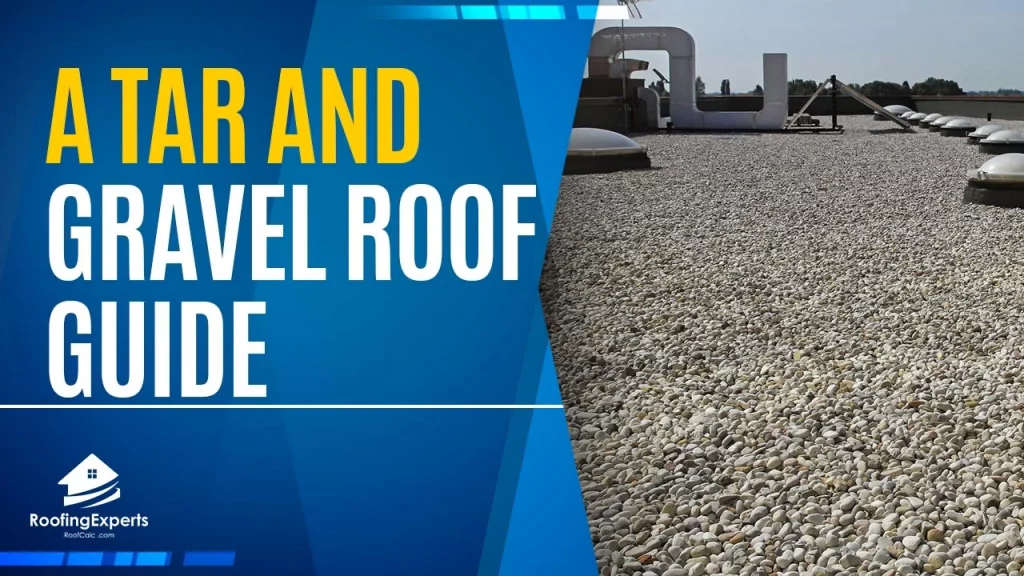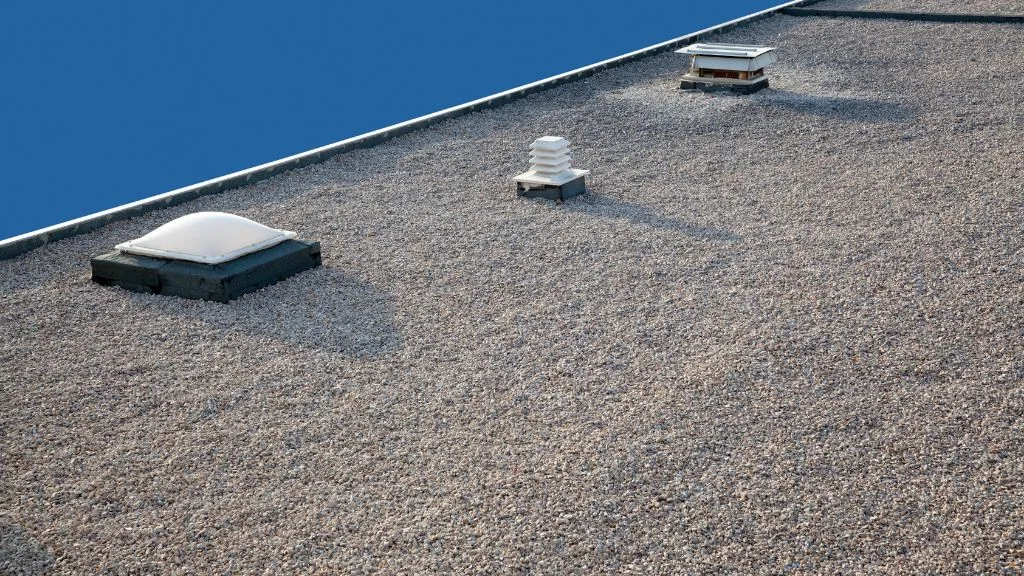
Tar & Gravel roofs are an excellent choice for homeowners who live in rural areas or have a rustic, country home. They offer fantastic protection from the elements and can be installed quickly.
However, there are some factors that you should consider before installing one on your property. In this guide, we will cover everything you need to know about tar & gravel roofing so that you can make the best decision for your home!
What is a Tar & Gravel Roof?
A tar & gravel roof is one of the most common types of metal roofs. It consists of a layer or layers of asphalt saturated felt that are then covered with sand, crushed rock and hot liquid bitumen (tar).
Built-up roofs, also called a tar and gravel roof, are popular because they can create an attractive look while providing you with the structural integrity of other types.
Gravel is used to protect the topmost layer of asphalt from forces that would otherwise damage it.
The gravel helps with water drainage, reflecting more intense UV rays which could lead to fading or cracking in this area as well protecting against natural threats like roof hail damage and heavy rains by keeping them at bay.
Tar is used to help bind the gravel layer together while also adding additional waterproofing.
The roof can hold this liquid better than any other type of material you could find and it will keep your home safe from heavy rains or major storms.
There are many different types of BURs, which require varying weight and density gravel depending on the underlying layers.
These need to be tailored for your specific building’s structure as well as climate in order not only look good but also last long!
The asphalt waterproofs the roof, but it’s not enough. The gravel layer extends its life by preventing water from penetrating into the shingles and doing damage to your home or business with wetness on top of dirt as well!
The Benefits of a Tar & Gravel Roof:
A tar and gravel roof has many benefits, such as reduced maintenance costs. The lifespan of a tar & gravel is usually 20 – 25 years, depending on location and structure.
One big advantage of the gravel embedded in your roof is that it will be more durable over time.
It can withstand all sorts of weather and still look new, instead of quickly deteriorating like normal tar paper would do if left unprotected by an effective waterproofing system!
The installation process takes some work but once finished you won’t have to worry about cracks or blisters forming from water damage ever again because this material doesn’t degrade easily.
Types of Tar & Gravel
There’s more than one way to get your roof looking great! You can choose between two main types of BUR or tar and gravel roofs: modified bitumen, which is a composite mixture with asphalt added in for extra durability.
And ballast in which this type might be better suited if you have larger stones because it will accommodate them while keeping weight down at the same time — though both styles come with their pros and cons; so do plenty of research before deciding on what would work best for yourself personally.
Modified Bitumen
Bitumen roofing systems are made up when modifiers are added to the typical asphalt, replacing plasticizers that have been removed during distillation.
Engineered and reinforced with fiberglass or polyester fibers, modified bitumen roofing are highly durable.
There are two types of modified bitumen roofs, SBS and APP.
The most common type is a Styrene-Butadiene-Styrene (SBS) which provides better sound absorption qualities than its counterpart atactic polypropylene or alternate plastic material designed specifically for this purpose.
SBS and APP work together to give a roof the flexibility it needs, while also making sure that system stays strong as time goes on.
When you’re looking for a roofing contractor, it’s important that they know what type will work best with your climate and application. An experienced professional can tell from their region of expertise which choice would be perfect for you!
If you’re looking for a durable and long-lasting roof, the modified bitumen is what’s best. It can withstand weather conditions that would otherwise destroy most materials in just one season!
The gravel helps improve water evaporation, holding heat and releasing it as well. This way your plants can better survive in dry conditions!
When you need to access your roof, or contractors are performing maintenance and repairs on the bitumen system of it; loose gravel is a good way for foot traffic because its surface provides better traction.
The gravel on modified bitumen roofs must be kept fairly level to prevent punctures or damage from foot traffic. Some of it should remain loose so that you can vacuum up small stones without leaving any rocks behind for people’s feet!
Applying a Tar & Gravel Roof
When it comes time to install your tar and gravel roof, you need to make sure that the surface is as clean as possible.
It should be free from dirt and debris which could lead to future problems like leaks or weak spots in the roof over time if left unattended for too long.
Make sure that the gravel is evenly spread out with a tarp underneath to help prevent any rocks from getting loose and flying away. This also helps you stay safe during installation!
After it’s done, make sure no debris remains behind on your roof or in the surrounding area because this could be dangerous for people walking around later if they happen upon something sharp or harmful; which is why you need to make sure everything gets cleaned up before the final touches are done.
Modified Bitumen vs Tar & Gravel
Both roofing systems have their pros and cons, so it’s important that you sit down with a professional beforehand to help figure out what would work best for your needs.
There are a lot of factors to consider when choosing between these two, including:
- Environmental conditions where you live; like rainfall and humidity.
- How often will your roof need maintenance if at all? -What’s the most budget friendly option for you that still meets your needs?
Modified Bitumen is more expensive than tar and gravel roofs, but this is because of the reinforcement with fiberglass or polyester fibers.
Tar and gravel roofs are a lot cheaper, but lack the strength that modified bitumen provides so you need to consider if your roof will be safe from damage over time as well as how much it costs on an annual basis for upkeep!
Some people may want more strength so they can avoid any costly maintenance in the future.
Modified Bitumen is resistant to fire and wind damage, but tar & gravel roofs are much lighter than their counterpart which makes them easier to transport during high winds!
The choice between these two roofing systems really just comes down to your own personal needs, whether you want protection against the elements or if you enjoy being able to see your roof from far away!
Ballast Tar & Gravel Roofing
Ballast roofing is a great choice for commercial properties that have access to readily available ballast.
It offers an attractive look and feel with the larger stones, which are perfect if you want something gritty or natural looking in your building’s exterior appeal!
Paving stones are an ideal way to create walkways that not only beautify your property but also add value. Ballast is a great option for roofing alternatives, including the popular EPDM and PVC varieties.
Ballast roofing systems are a popular choice because they offer Class-A fire resistance, sustainability and easy repair. Ballasts also have an added benefit of being energy efficient overall!
Tar & Gravel Roofing Maintenance
Tar and gravel roofs are a long-term investment. The presence of tar in the roofing material gives it strength, while its natural surface helps to prevent leaks from occurring more often than not!
You can add more insulation to your roof by adding layers of fiberglass or foam.
You may also want to apply a cool floor coating that will help keep it from getting wet in rainstorms, which could lead to you needlessly paying for water damage repair services every time there is heavy rainfall!
Tar & Gravel Roofing Repairs
A good roof is one that will last you decades of service. If your house has a BUR system, it’s best to leave repairs for professionals because they have the expertise needed in order to make sure everything gets fixed properly and efficiently while also ensuring long-lasting results!
If you have a flat roof, then there’s a good chance that it has been leaking. The leaks can come from any number of places – tar or gravel roofs are common locations for them!
In order to fix this problem and prevent further damage try these tips:
1. Look around your home for areas with missing chunks in their surface
2. Check under eaves where water may collect if they aren’t sealed tightly enough against the gutter system below
3. Examine any flashing valves on either side which could lead directly down into gutters along with other flushing components such as chimneys/fireplaces
4. Investigate spots outside near corners where wind gusts might result in damage
If you feel comfortable doing so, then try to repair the roof yourself.
However, if problems are too complex or beyond your skill set then it is best to contact a professional that can fix these issues for you!
This goes without saying that if you’re considering a commercial property with an existing, tar and gravel roof then many leaks might indicate significant amounts of past issues. This is not what anyone wants in their building!
When you buy a new property, it’s important to consult with both your public adjuster and the building inspector. This way we can make sure everything is safe before moving in!
It’s no surprise that an experienced professional can help you avoid leaks.
A roof leak is usually just a matter of sloppy workmanship on the part of someone who doesn’t know what they’re doing, but with proper patching by professionals in this field?
Your home will be protected from water damage for years to come!
If you’re experiencing any of the following, your roof needs to be replaced: more than 25% covered in patches or cracks. If you’re looking to buy a property with this type of flat roofing, walk on the roof yourself and see how it feels.
There are many indications that this roof will likely need to be replaced sooner rather than later, like loose areas and cracks in the surface.
It’s your decision if you think it is worth investing into; however I would recommend looking at other roofs before making any decisions regarding costs or time frames for repairs.


